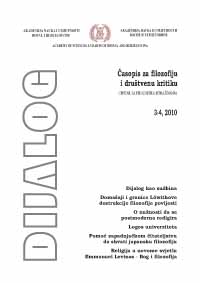Pomoć zapadnjačkom čitateljstvu da shvati japansku filozofiju
Helping Western Readers Understand Japanese Philosophy
Author(s): Thomas P. KasulisSubject(s): Philosophy
Published by: Akademija Nauka i Umjetnosti Bosne i Hercegovine
Keywords: Japanese philosophy; Western readers; holographic models; interdependence of knower and known; cultural and intellectual gap; pedagogical model of transmission; argument by relegation
Summary/Abstract: Thomas P. Kasulis’ article offers a series of hermeneutical keys for opening Japanese philosophy to Western readers, ignorant of the original language and the cultural baggage that it carries. He recommends paying attention to the questions, often tacitly assumed and in the background, that particular authors were trying to answer, and loosening the controls of historical context and intellectual biography in favor of more heuristic and pragmatic goals. Far from trying to simply universalize, or totally decontextualize Japanese thought, Kasulis proposes a series of generalized principles to keep in mind: its tendency to seek out internal relationships (a principle of intimacy), especially between the knower and the known but also between the mind and the body which are viewed as inseparable; the importance given to apprenticeship as practice under a master; the preference for the how over the what (for functions rather than substances); the appeal to holographic models (even at the ontological level) in which the parts are in the whole and the whole in each of the parts; the habitual use of “argument by relegation” that includes opposing views without any attempt to refute them from within a broader perspective; and the tendency to track down the origin of contradictions rather than explain them teleological.
Journal: Dijalog - Časopis za filozofiju i društvenu teoriju
- Issue Year: 2010
- Issue No: 03+04
- Page Range: 83-99
- Page Count: 17
- Language: Bosnian

